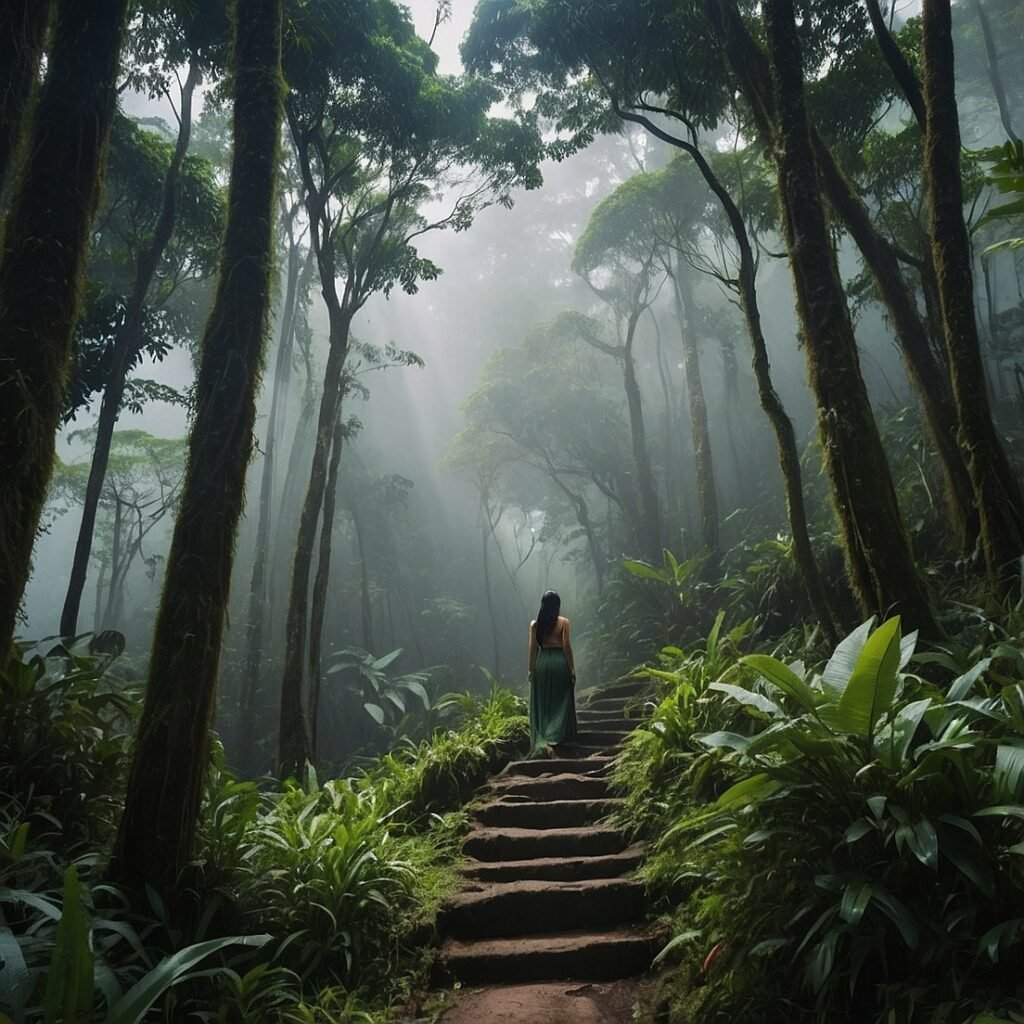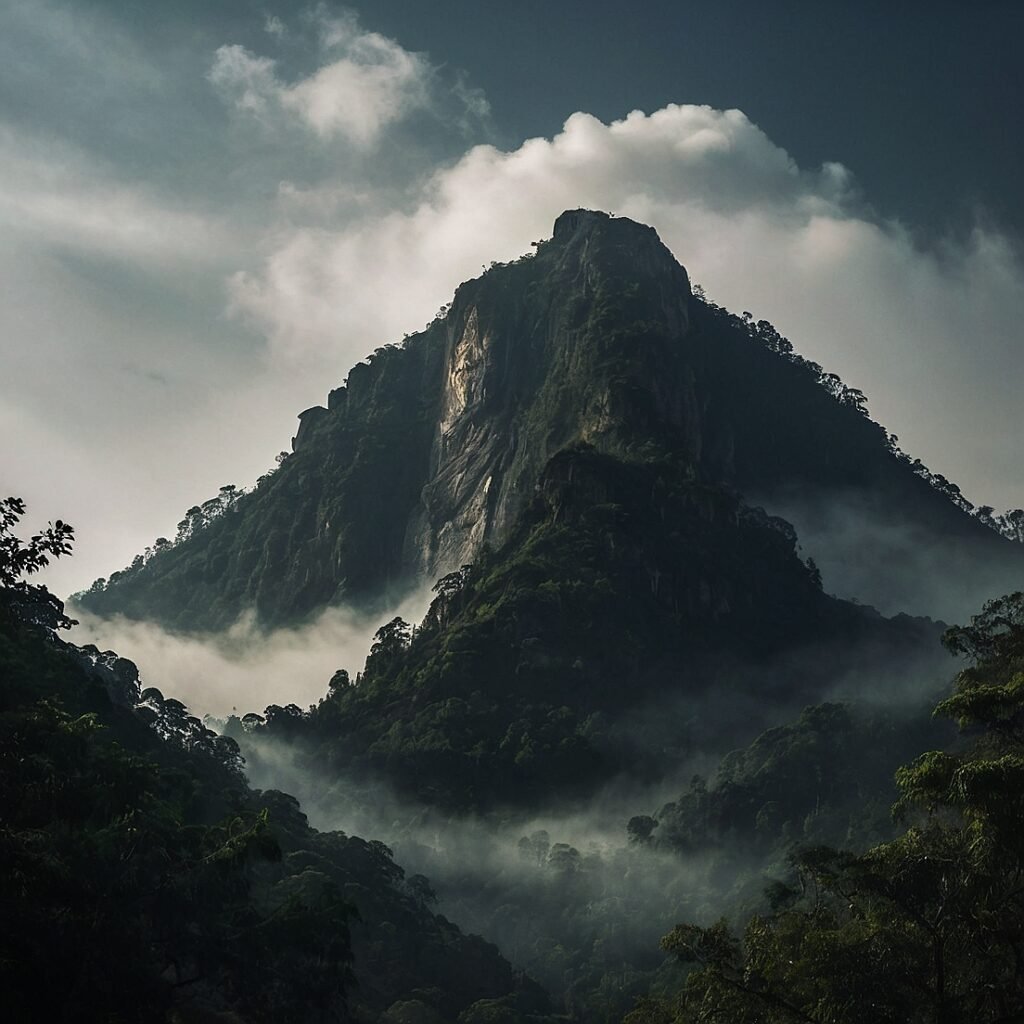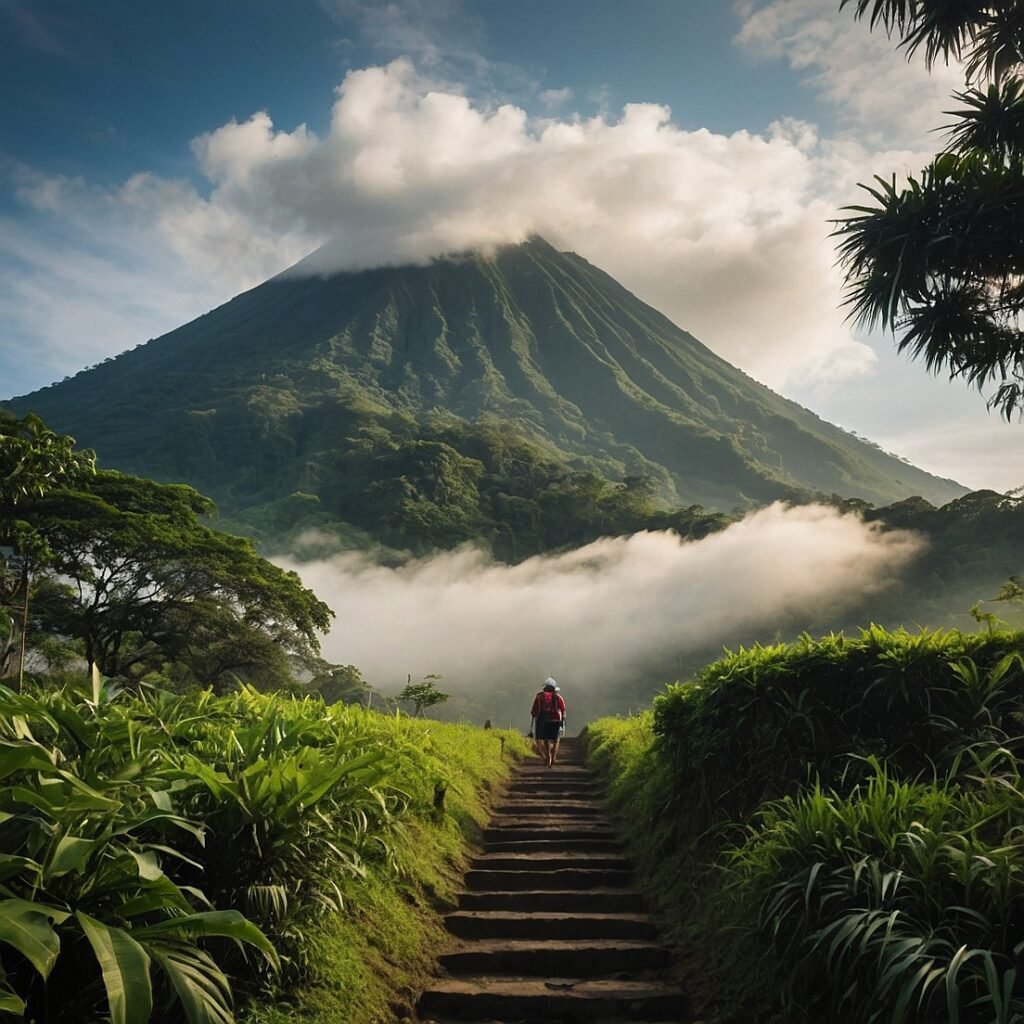Growing up in the Philippines, I was always fascinated by the rich tapestry of folklore that surrounded me. From the whispered tales of my grandmother to the colorful stories shared during fiestas, Tagalog folklore has been an integral part of my cultural identity. Today, I want to take you on a journey through the enchanting world of Philippine mythology, with a special focus on one of its most beloved figures: Maria Makiling.
As we delve into these ancient tales, you’ll discover a realm where nature spirits coexist with humans, where mountains hold secrets, and where love can transcend the boundaries between the mortal and the divine. So, sit back, relax, and let’s explore the captivating stories that have shaped the Filipino imagination for generations.
The Legend of Maria Makiling: Guardian of Mount Makiling
The Mountain Goddess
At the heart of Laguna province stands the majestic Mount Makiling, a dormant volcano shrouded in mystery and legend. It’s here that the story of Maria Makiling, one of the most famous figures in Tagalog folklore, unfolds. Maria Makiling is more than just a mythical character; she’s the embodiment of nature’s beauty and power, the guardian spirit of the mountain that bears her name.
I remember the first time I heard about Maria Makiling during a family trip to Los Baños, a town nestled at the foot of Mount Makiling. Our tour guide spoke of her with such reverence that I couldn’t help but be drawn into the tale. According to legend, Maria appears as a stunningly beautiful young woman with long, flowing hair and eyes that sparkle like dewdrops in the morning sun.
Maria’s Benevolence
What makes Maria Makiling so beloved in Filipino culture is her kindness and generosity. The stories tell of how she would help farmers by making their crops more bountiful and guiding lost travelers back to safety. She’s said to have a particular fondness for hardworking and honest individuals, often rewarding them with gifts from the mountain’s abundant resources.
One of my favorite stories about Maria involves a poor woodcutter. One day, while gathering firewood on the mountain, he stumbled upon Maria’s dwelling. Impressed by his humility and hard work, she gifted him with a basket full of ginger. The woodcutter, not realizing the value of the gift, carelessly spilled most of it on his way home. It was only when he arrived that he discovered the remaining pieces had turned to gold!
The Heartbreak of Maria Makiling
But not all stories about Maria Makiling are filled with joy. There’s a poignant tale of love and betrayal that explains why the goddess became reclusive and why mists often shroud the mountain. The story goes that Maria fell in love with a mortal man, a hunter named Juan. Their love was pure and beautiful, but Juan was eventually lured away by a town beauty.
Heartbroken, Maria retreated deep into the mountain, her tears forming the springs and waterfalls that now cascade down Mount Makiling’s slopes. The mists that often envelop the mountain are said to be Maria’s veil, hiding her sorrow from the world below.
This tale of love and loss resonates deeply with many Filipinos, myself included. It reminds us of the power of emotions and the consequences of our actions, even when dealing with divine beings.
Other Enchanting Figures in Tagalog Folklore
While Maria Makiling might be one of the most well-known figures in Tagalog folklore, she’s far from the only one. The Philippines is home to a vast pantheon of mythical creatures and legendary beings. Let me introduce you to some of the other fascinating characters that populate our stories.
Bakunawa: The Moon-Eating Dragon
One of the most awe-inspiring creatures in Philippine mythology is the Bakunawa, a gigantic sea serpent often depicted as a dragon. The Bakunawa is said to be so massive that it can swallow the moon, causing eclipses. As a child, I remember being both terrified and fascinated by this creature during lunar eclipses.
The legend goes that there were once seven moons in the sky, and the Bakunawa, attracted by their beauty, began to eat them one by one. To save the last moon, the supreme god Bathala instructed people to make noise by banging on pots and pans to scare the Bakunawa away. This is why, even today, some older Filipinos still practice this tradition during eclipses.
Tikbalang: The Horse-Human Trickster
Another intriguing figure in Tagalog folklore is the Tikbalang, a creature with the head of a horse and the body of a human. These beings are known for their mischievous nature, often leading travelers astray in the forests. I’ve heard countless stories from relatives who claim to have encountered Tikbalangs during their journeys through rural areas.
According to legend, if you find yourself lost due to a Tikbalang’s tricks, you can break its spell by wearing your shirt inside out. Some stories even suggest that if you can leap onto a Tikbalang’s back and tame it, the creature will grant you special powers or lead you to hidden treasures.
Diwata: Nature Spirits of Beauty and Power
No discussion of Tagalog folklore would be complete without mentioning the Diwata. These nature spirits, often described as ethereally beautiful women, are guardians of the natural world. Each Diwata is associated with a particular element or aspect of nature, such as trees, rivers, or mountains.
Maria Makiling herself is sometimes referred to as a Diwata, although her legend has grown to make her more than just a nature spirit. Other famous Diwata include Maria Sinukuan of Mount Arayat and Maria Cacao of Cebu. These beings are known for their power to bless or curse, depending on how humans treat their domains.
The Role of Folklore in Filipino Culture
Preserving Heritage and Values
As I reflect on these stories that have been passed down through generations, I’m struck by how integral they are to Filipino culture. These tales do more than entertain; they serve as vessels for our values, beliefs, and way of life. The story of Maria Makiling, for instance, teaches us about the importance of respecting nature and the consequences of betrayal.
Similarly, legends about other mythical creatures often carry moral lessons. The mischievous Tikbalang reminds us to stay on the right path, both literally and figuratively. The Diwata encourage us to live in harmony with nature, respecting the delicate balance of our ecosystem.
Connecting Past and Present
In our rapidly modernizing world, these ancient stories provide a crucial link to our past. They help us understand the worldview of our ancestors and the way they made sense of natural phenomena. The Bakunawa eating the moon is a prime example of how pre-colonial Filipinos explained eclipses in the absence of scientific knowledge.
Moreover, these legends often tie into real geographical locations, like Mount Makiling or Mount Arayat, giving these places a deeper significance in our cultural landscape. This connection between myth and reality helps to root our identity in the physical land we inhabit.
Inspiring Creativity
Tagalog folklore continues to inspire Filipino artists, writers, and filmmakers. From movies and TV shows to contemporary literature and visual arts, these ancient tales are constantly being reimagined and retold for new generations. This ongoing reinterpretation keeps our folklore alive and relevant in the modern world.
I’ve personally seen how these stories spark creativity in young Filipinos. In school art contests, it’s common to see depictions of Maria Makiling or the Tikbalang alongside more modern subjects. This blend of the ancient and the contemporary is a testament to the enduring power of our folklore.
The Evolution of Tagalog Folklore
Pre-Colonial Roots
To truly appreciate Tagalog folklore, we need to understand its origins. Many of these stories date back to pre-colonial times when animistic beliefs were prevalent among the indigenous peoples of the Philippines. The concept of nature spirits like the Diwata, for example, reflects the deep connection our ancestors had with the natural world.
It’s fascinating to think about how these stories have survived centuries of cultural change. Despite the influences of Spanish colonization and American occupation, many of these ancient tales have retained their core elements, adapting and evolving along the way.
Colonial Influences
The arrival of the Spanish in the 16th century brought significant changes to Philippine culture, including our folklore. Christianity became a dominant force, and many of our ancient myths were reinterpreted through a Christian lens. Some scholars argue that the figure of Maria Makiling, with her association with the Virgin Mary, may have been influenced by this cultural mixing.
Similarly, some of our mythical creatures took on more sinister roles under Spanish influence. The Aswang, for instance, a shape-shifting creature in Filipino folklore, became more closely associated with evil and the devil in colonial-era stories.
Modern Interpretations
In recent years, there’s been a renewed interest in Tagalog folklore among Filipino scholars and artists. This has led to new interpretations and adaptations of these ancient tales. For example, some modern retellings of Maria Makiling’s story portray her as an environmental activist, fighting against deforestation and pollution.
This evolution of our folklore demonstrates its resilience and relevance. As our society changes, these stories adapt, continuing to reflect our values and concerns while maintaining a connection to our cultural roots.
Comparative Mythology: Tagalog Folklore in a Global Context
Universal Themes
As I’ve delved deeper into Tagalog folklore, I’ve been struck by how many themes and motifs are shared with mythologies from around the world. The concept of a benevolent mountain spirit like Maria Makiling, for instance, can be found in various cultures, from the Appalachian “Wood’s Wife” to the Japanese mountain kami.
Similarly, the Bakunawa has parallels in other cultures’ myths about celestial dragons or serpents causing eclipses. In Norse mythology, the wolf Hati chases the moon, while in Hindu mythology, the demon Rahu swallows the sun or moon.
Unique Filipino Elements
While there are universal elements, Tagalog folklore also has uniquely Filipino aspects that reflect our specific geography, history, and culture. The Tikbalang, with its horse-human hybrid form, is distinctively Filipino. Its association with bamboo groves and its ability to be tamed by a brave human are elements that speak to our local environment and values.
The table below highlights some of the unique characteristics of key figures in Tagalog folklore:
| Mythical Figure | Unique Characteristics | Cultural Significance |
|---|---|---|
| Maria Makiling | Associated with a specific mountain; Embodies nature’s beauty and generosity | Teaches respect for nature; Represents ideal Filipino beauty |
| Bakunawa | Moon-eating dragon; Can be scared away by noise | Explains eclipses; Encourages community action |
| Tikbalang | Horse-head on human body; Can be outsmarted by wearing clothes inside-out | Warns against straying from the right path; Encourages cleverness |
| Diwata | Nature spirits with specific domains; Can bless or curse | Promotes harmony with nature; Embodies the beauty of the natural world |
Preserving Tagalog Folklore for Future Generations
The Challenge of Modernization
As we move further into the 21st century, preserving these ancient tales becomes increasingly important. With urbanization and the influx of global popular culture, there’s a risk that younger generations might lose touch with these stories that have shaped our cultural identity for centuries.
I’ve noticed this challenge firsthand. When I talk to my younger cousins about Maria Makiling or the Tikbalang, they’re often more familiar with Western folklore or Japanese anime characters. While there’s nothing wrong with enjoying stories from other cultures, I believe it’s crucial that we don’t lose sight of our own rich mythological heritage.
Educational Initiatives
Fortunately, there are efforts to keep Tagalog folklore alive in the modern era. Many schools in the Philippines now include local myths and legends in their curriculum, recognizing the importance of these stories in shaping cultural identity. There are also educational TV shows and online resources dedicated to sharing these tales with a new generation.
I’m particularly excited about interactive digital projects that bring these stories to life. Imagine exploring Mount Makiling in a virtual reality environment, encountering Maria and other mythical beings along the way. Such initiatives could make our folklore more accessible and engaging for tech-savvy youth.
Contemporary Retellings
Another way our folklore stays relevant is through contemporary retellings in various media. Filipino authors, filmmakers, and artists continue to draw inspiration from these ancient tales, creating new works that resonate with modern audiences while staying true to the spirit of the original stories.
For example, the 2016 film “Bakunawa” by Maricel Cariaga reimagines the moon-eating dragon in a contemporary setting, using the myth to explore themes of environmental destruction and cultural loss. Such adaptations not only preserve our folklore but also demonstrate its continued relevance in addressing modern issues.
The Enduring Magic of Tagalog Folklore
As we come to the end of our journey through the enchanting world of Tagalog folklore, I’m reminded of why these stories have captivated me since childhood. They’re more than just tales of magical beings and supernatural events; they’re a window into the soul of Filipino culture, reflecting our values, fears, hopes, and dreams.
From the benevolent Maria Makiling, watching over her mountain domain, to the mischievous Tikbalang leading travelers astray, these figures embody aspects of the Filipino psyche. They teach us to respect nature, to be kind to others, to be clever in the face of adversity, and to recognize the magic that exists in the world around us.
As we face the challenges of the modern world, I believe these ancient stories have an important role to play. They remind us of our connection to the land, to our ancestors, and to each other. They offer wisdom that’s as relevant today as it was centuries ago, packaged in tales that continue to captivate and inspire.
So the next time you find yourself in a misty forest or gazing at a mountain shrouded in clouds, take a moment to remember these stories. Who knows? You might just catch a glimpse of Maria Makiling watching over her domain, or hear the distant sound of gongs being struck to ward off the Bakunawa. After all, in the world of Tagalog folklore, magic is always just around the corner.
Disclaimer: This blog post is based on traditional Tagalog folklore and contemporary interpretations up to 2016. Mythological stories often have multiple versions and interpretations that may vary across different regions and time periods. While every effort has been made to present accurate information, some details may vary from other accounts. If you notice any inaccuracies, please report them so we can correct them promptly.




